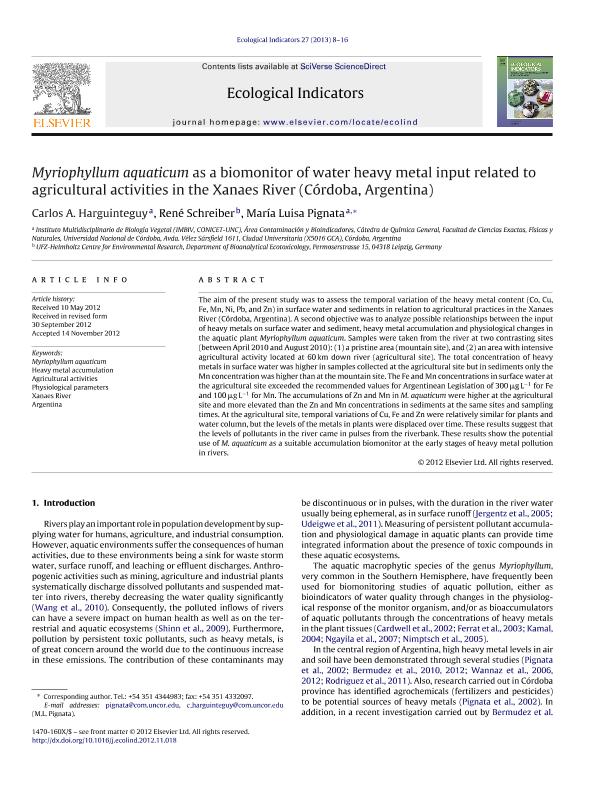Mostrar el registro sencillo del ítem
dc.contributor.author
Harguinteguy, Carlos Alfredo

dc.contributor.author
Schreiber, Sebastian Rene

dc.contributor.author
Pignata, Maria Luisa

dc.date.available
2015-07-20T20:58:18Z
dc.date.issued
2013-01
dc.identifier.citation
Harguinteguy, Carlos Alfredo; Schreiber, Sebastian Rene; Pignata, Maria Luisa; Myriophyllum aquaticum as a biomonitor of water heavy metal input related to agricultural activities in the Xanaes River (Córdoba, Argentina); Elsevier Science; Ecological Indicators; 27; 1-2013; 8-16
dc.identifier.issn
1470-160X
dc.identifier.uri
http://hdl.handle.net/11336/1287
dc.description.abstract
The aim of the present study was to assess the temporal variation of the heavy metal content (Co, Cu, Fe, Mn, Ni, Pb, and Zn) in surface water and sediments in relation to agricultural practices in the Xanaes River (Córdoba, Argentina). A second objective was to analyze possible relationships between the input of heavy metals on surface water and sediment, heavy metal accumulation and physiological changes in the aquatic plant Myriophyllum aquaticum. Samples were taken from the river at two contrasting sites (between April 2010 and August 2010): (1) a pristine area (mountain site), and (2) an area with intensive agricultural activity located at 60 km down river (agricultural site). The total concentration of heavy metals in surface water was higher in samples collected at the agricultural site but in sediments only the Mn concentration was higher than at the mountain site. The Fe and Mn concentrations in surface water at the agricultural site exceeded the recommended values for Argentinean Legislation of 300 g L−1 for Fe and 100 g L−1 for Mn. The accumulations of Zn and Mn in M. aquaticum were higher at the agricultural site and more elevated than the Zn and Mn concentrations in sediments at the same sites and sampling times. At the agricultural site, temporal variations of Cu, Fe and Zn were relatively similar for plants and water column, but the levels of the metals in plants were displaced over time. These results suggest that the levels of pollutants in the river came in pulses from the riverbank. These results show the potential use of M. aquaticum as a suitable accumulation biomonitor at the early stages of heavy metal pollution in rivers.
dc.format
application/pdf
dc.language.iso
eng
dc.publisher
Elsevier Science

dc.rights
info:eu-repo/semantics/openAccess
dc.rights.uri
https://creativecommons.org/licenses/by-nc-nd/2.5/ar/
dc.subject
AGRICULTURAL ACTIVITIES
dc.subject
ARGENTINA
dc.subject
HEAVY METAL ACCUMULATION
dc.subject
MYRIOPHYLLUM AQUATICUM
dc.subject
PHYSIOLOGICAL PARAMETERS
dc.subject
XANAES RIVER
dc.subject.classification
Geología

dc.subject.classification
Ciencias de la Tierra y relacionadas con el Medio Ambiente

dc.subject.classification
CIENCIAS NATURALES Y EXACTAS

dc.subject.classification
Agricultura

dc.subject.classification
Agricultura, Silvicultura y Pesca

dc.subject.classification
CIENCIAS AGRÍCOLAS

dc.title
Myriophyllum aquaticum as a biomonitor of water heavy metal input related to agricultural activities in the Xanaes River (Córdoba, Argentina)
dc.type
info:eu-repo/semantics/article
dc.type
info:ar-repo/semantics/artículo
dc.type
info:eu-repo/semantics/publishedVersion
dc.date.updated
2016-03-30 10:35:44.97925-03
dc.journal.volume
27
dc.journal.pagination
8-16
dc.journal.pais
Países Bajos

dc.journal.ciudad
Amsterdam
dc.description.fil
Fil: Harguinteguy, Carlos Alfredo. Consejo Nacional de Investigaciones Científicas y Técnicas. Centro Científico Tecnológico - CONICET - Córdoba. Instituto Multidisciplinario de Biología Vegetal (p); Argentina
dc.description.fil
Fil: Schreiber, Sebastian Rene. Consejo Nacional de Investigaciones Científicas y Técnicas. Centro Científico Tecnológico Conicet - Córdoba; Argentina
dc.description.fil
Fil: Pignata, Maria Luisa. Consejo Nacional de Investigaciones Científicas y Técnicas. Centro Científico Tecnológico - CONICET- Córdoba. Instituto Multidisciplinario de Biología Vegetal (p); Argentina
dc.journal.title
Ecological Indicators

dc.relation.alternativeid
info:eu-repo/semantics/altIdentifier/url/http://www.sciencedirect.com/science/article/pii/S1470160X12004062
dc.relation.alternativeid
info:eu-repo/semantics/altIdentifier/doi/http://dx.doi.org/10.1016/j.ecolind.2012.11.018
Archivos asociados
